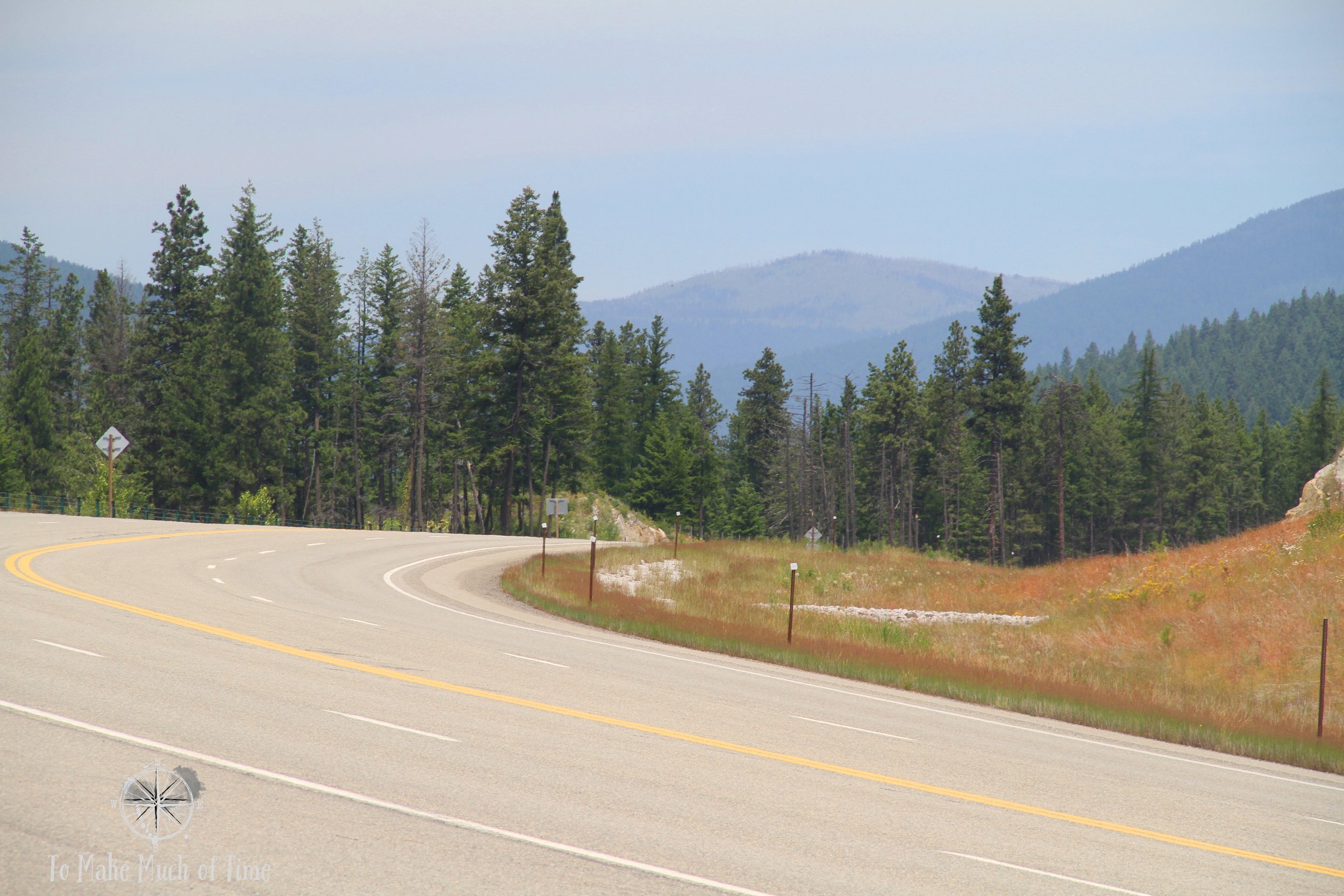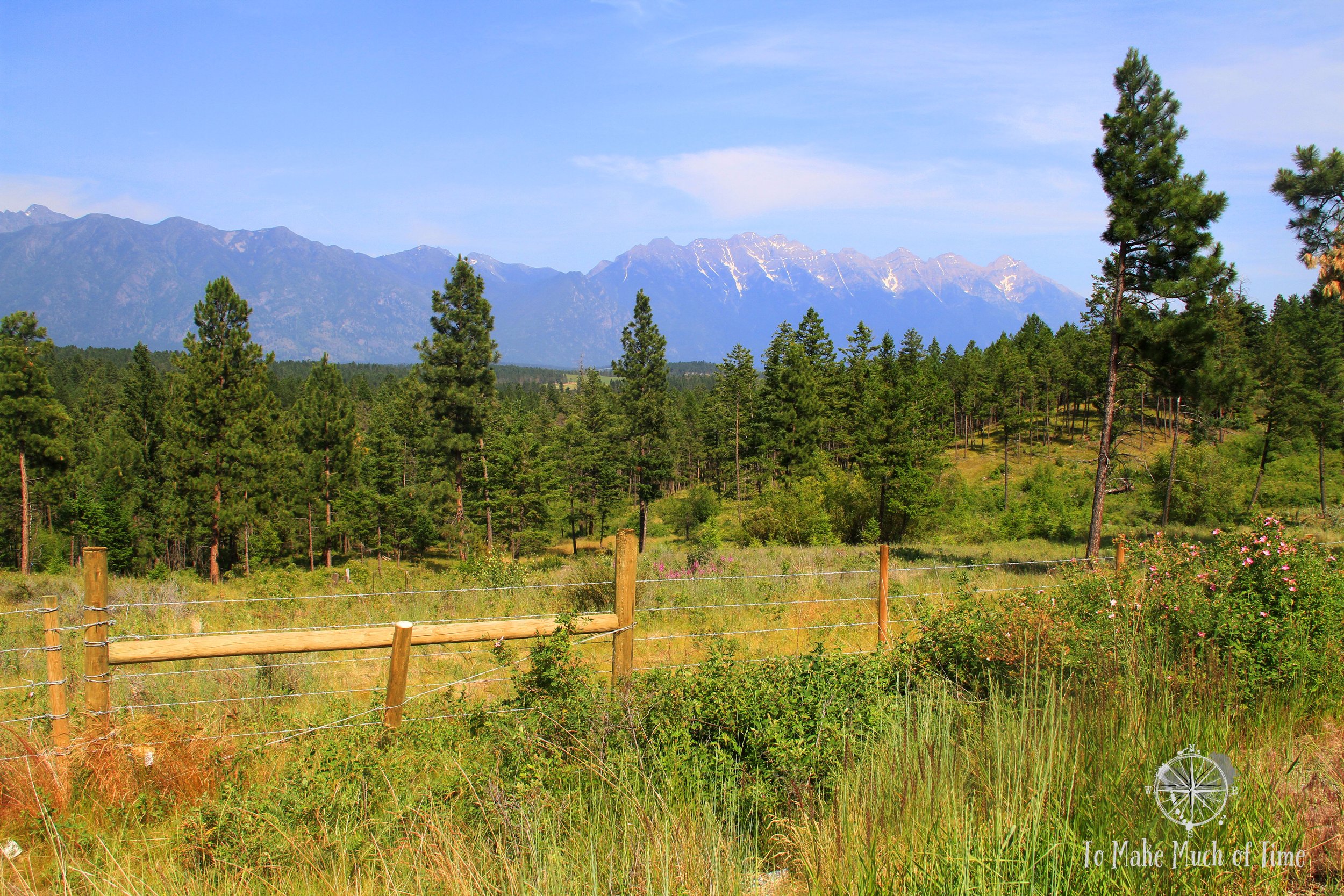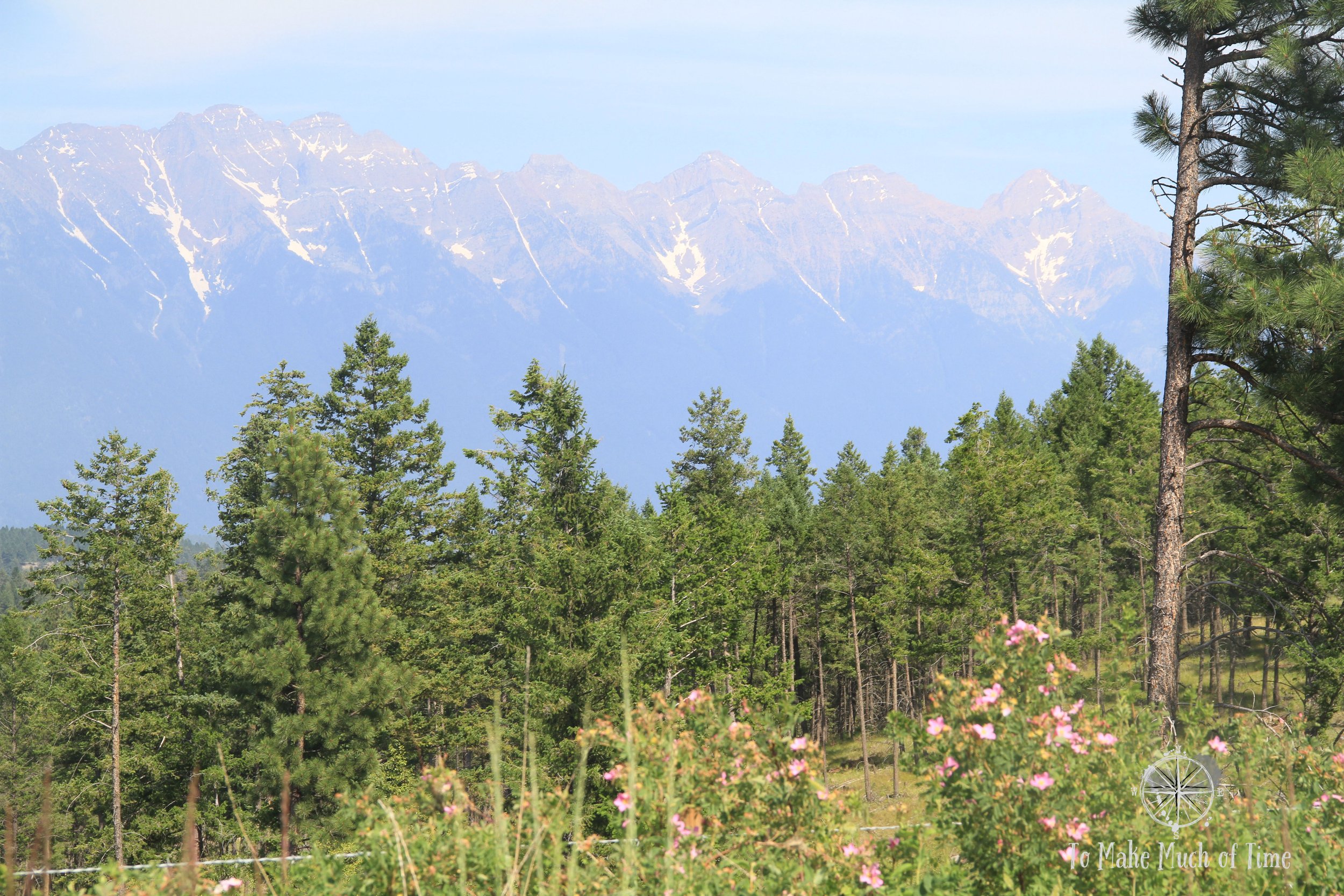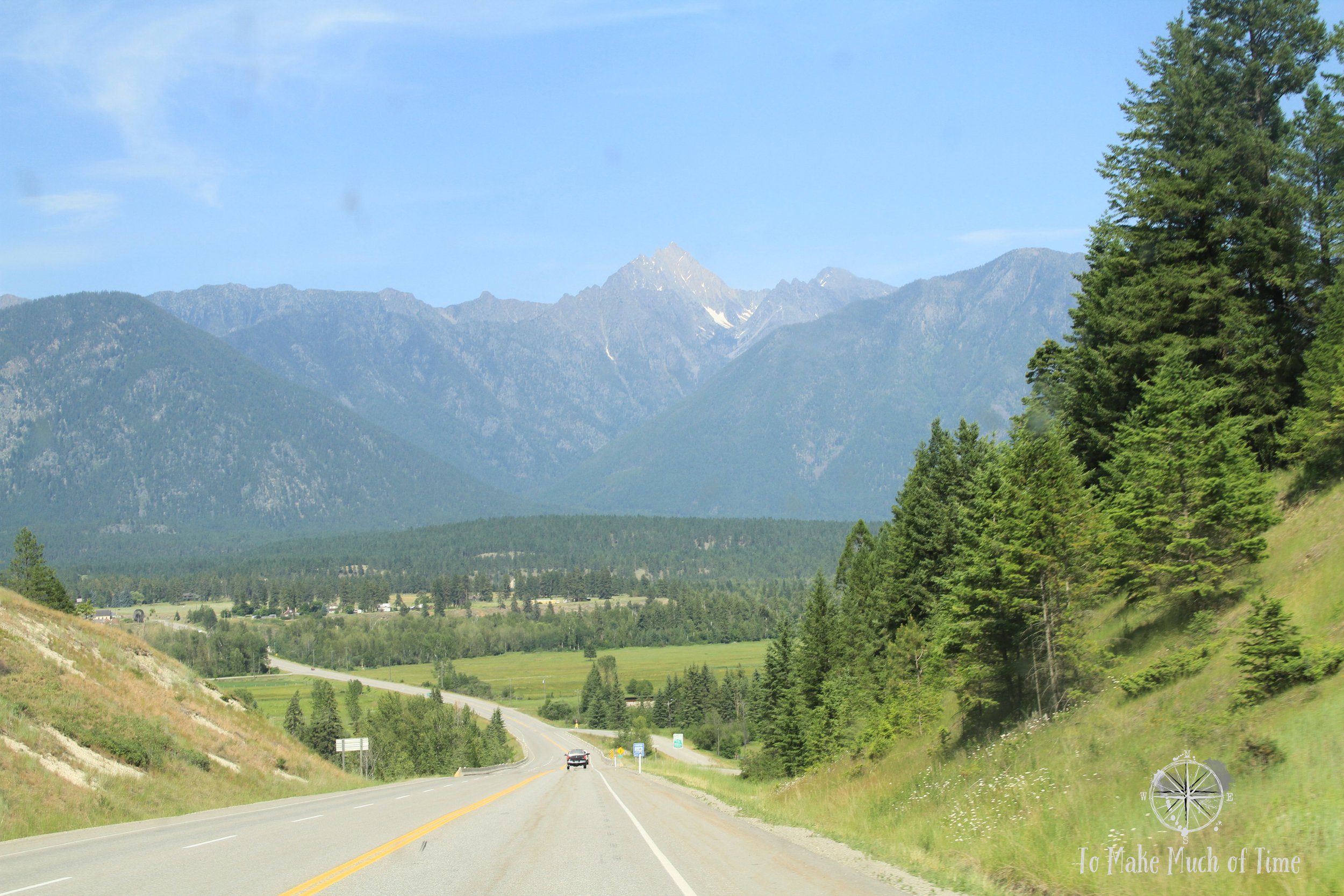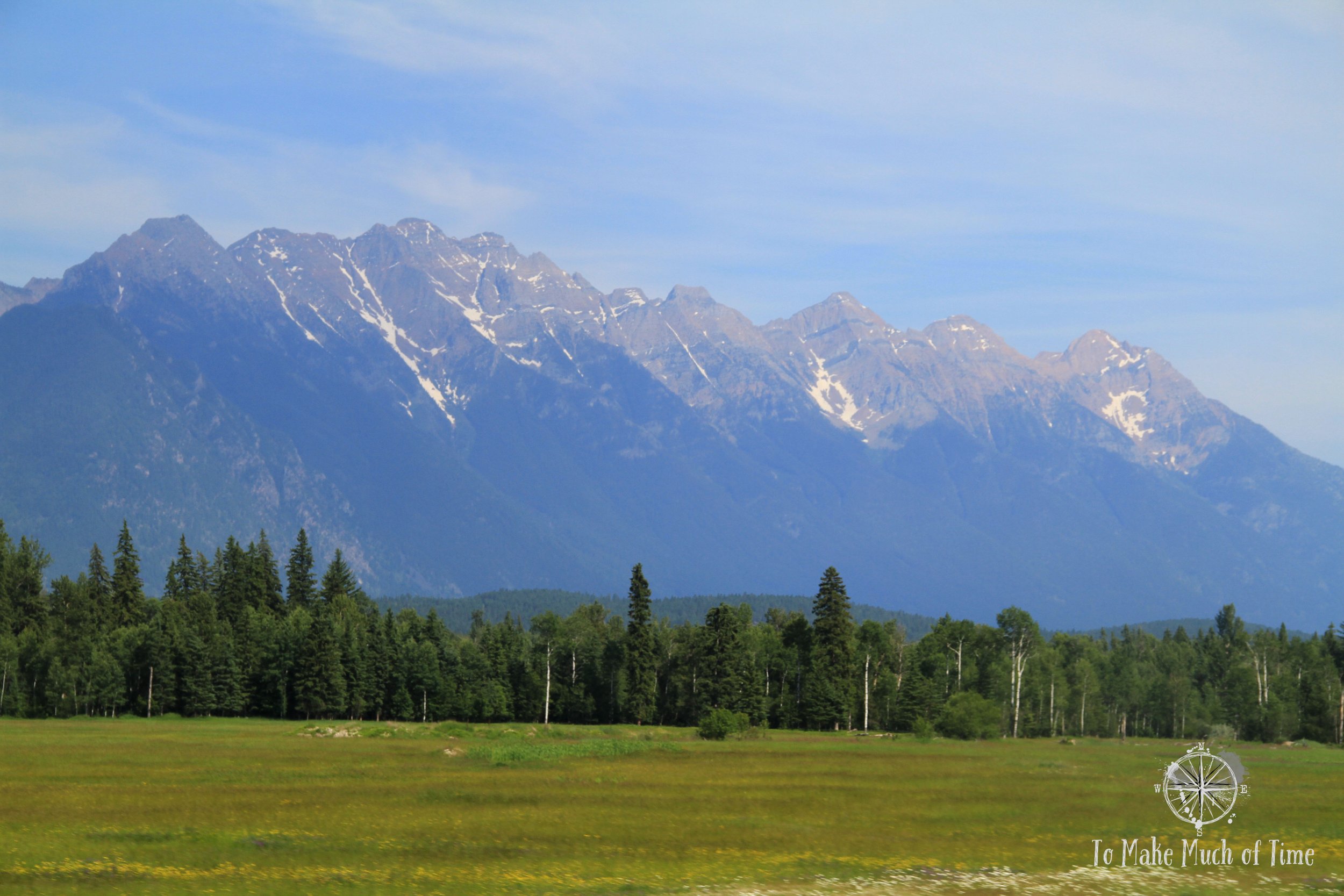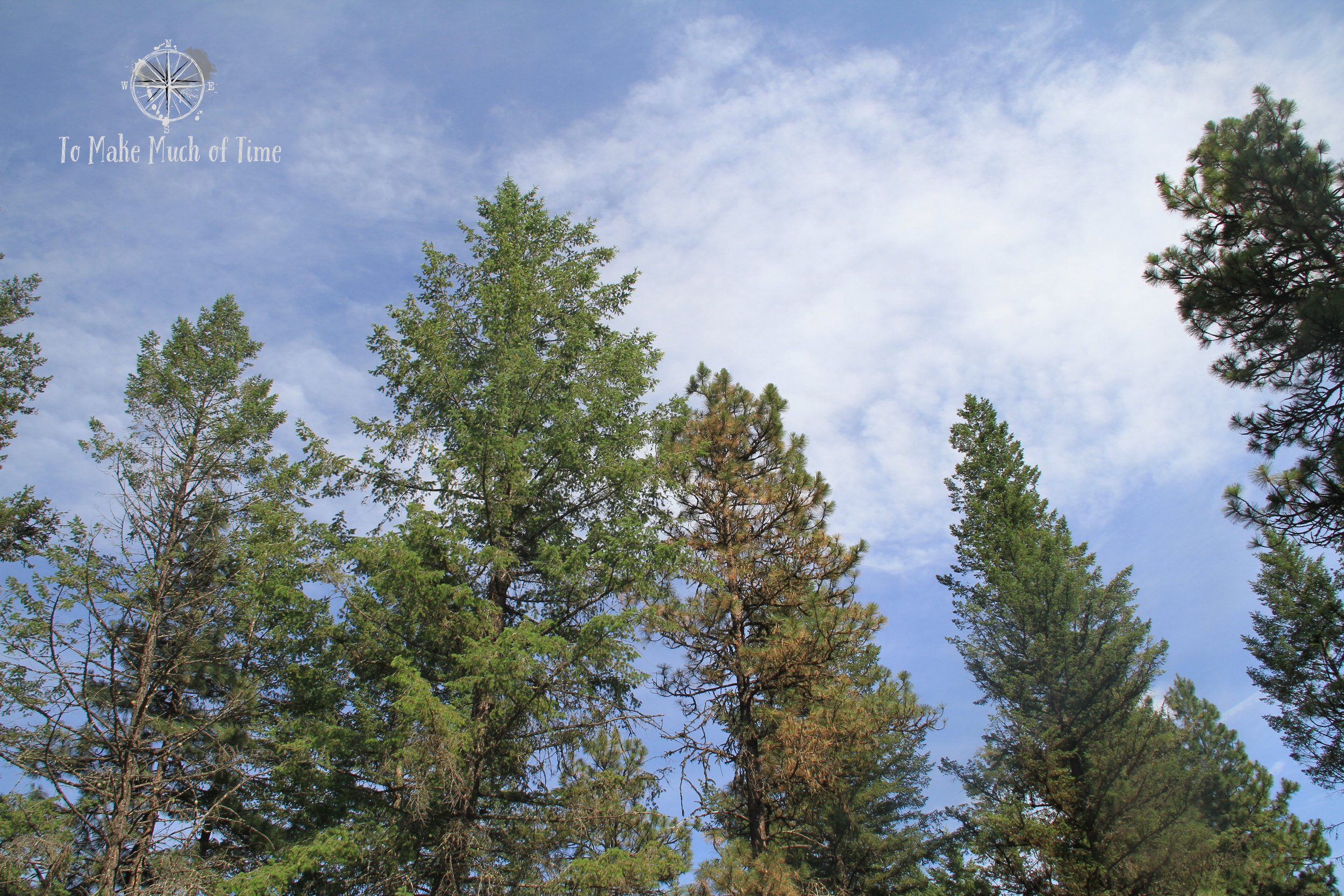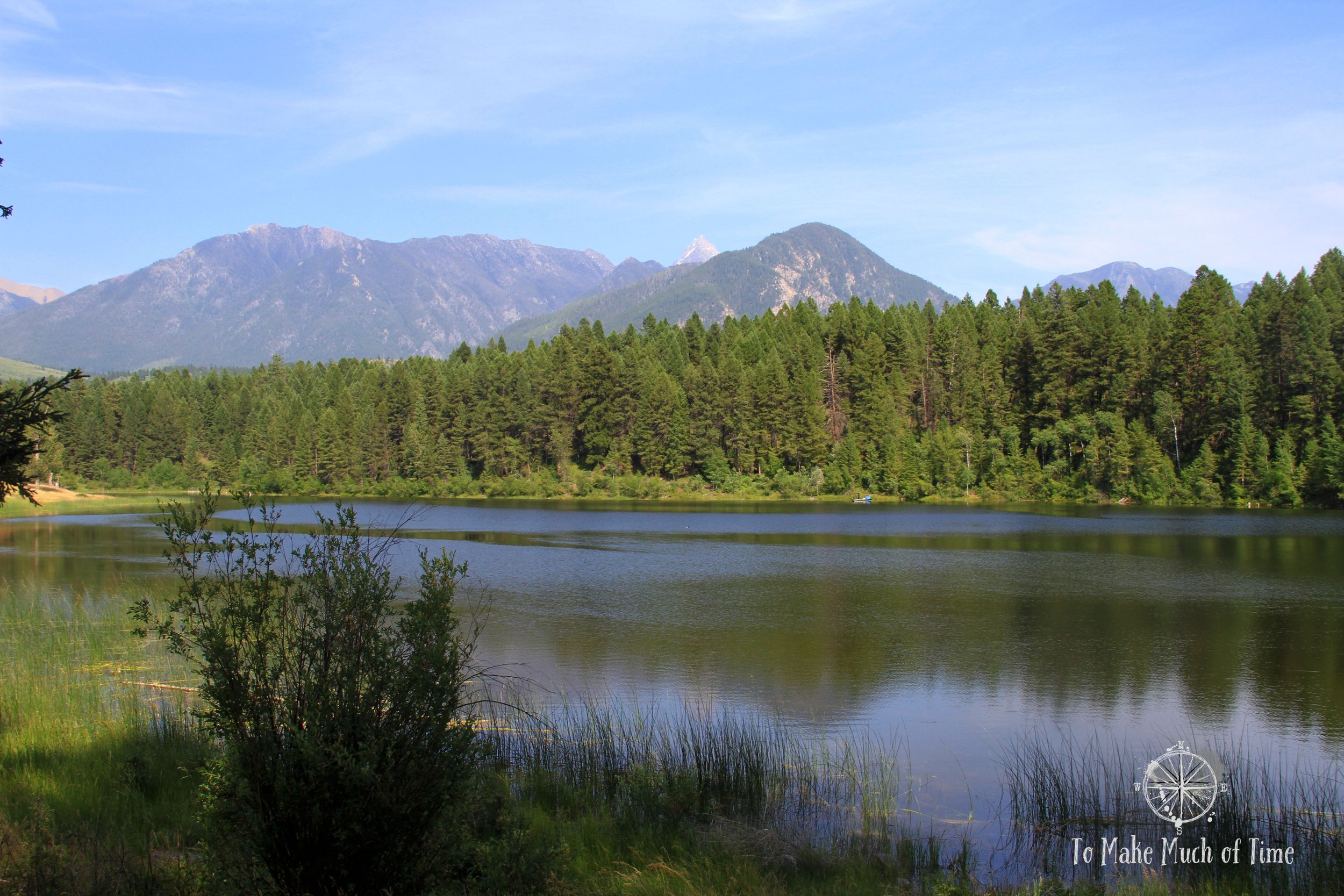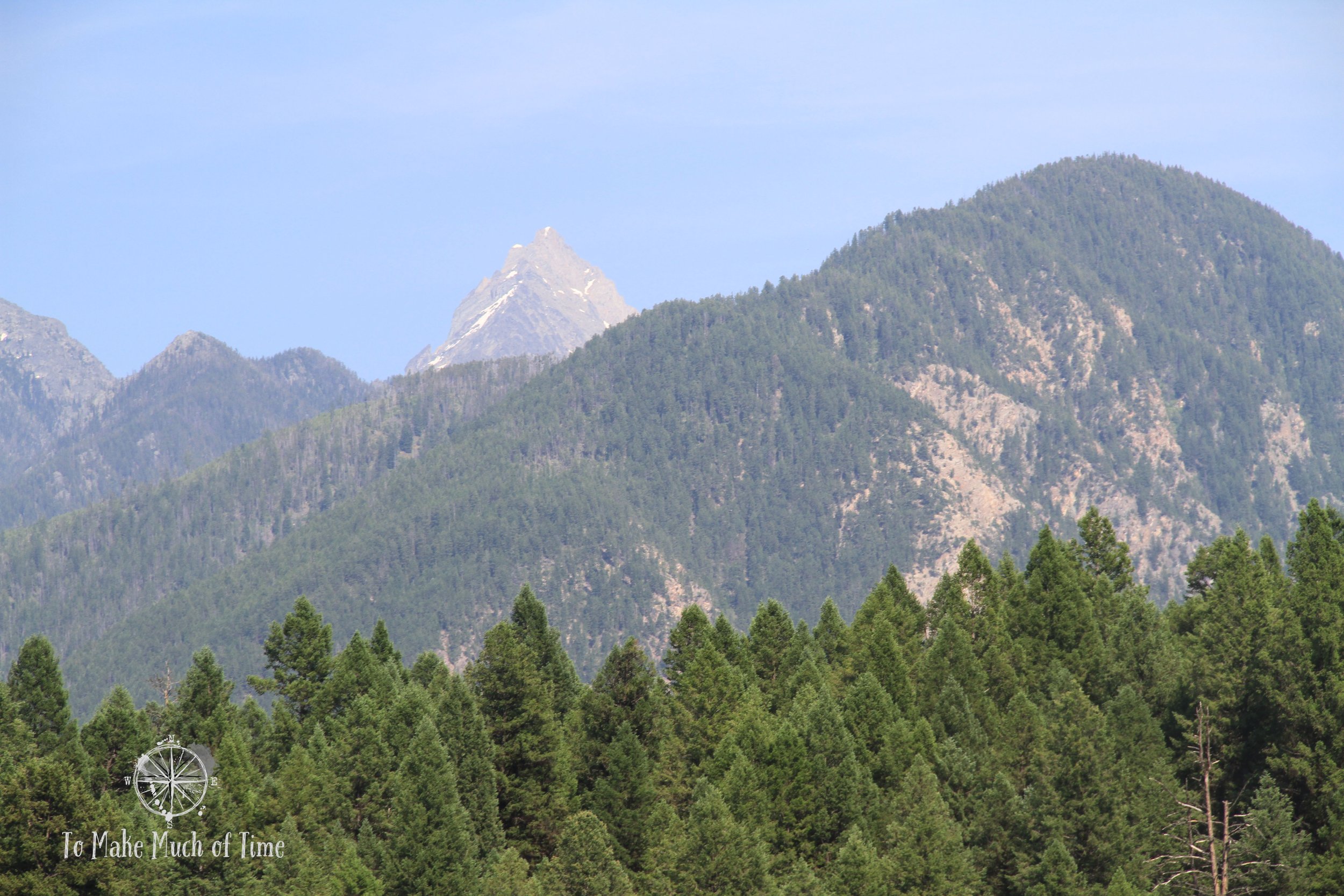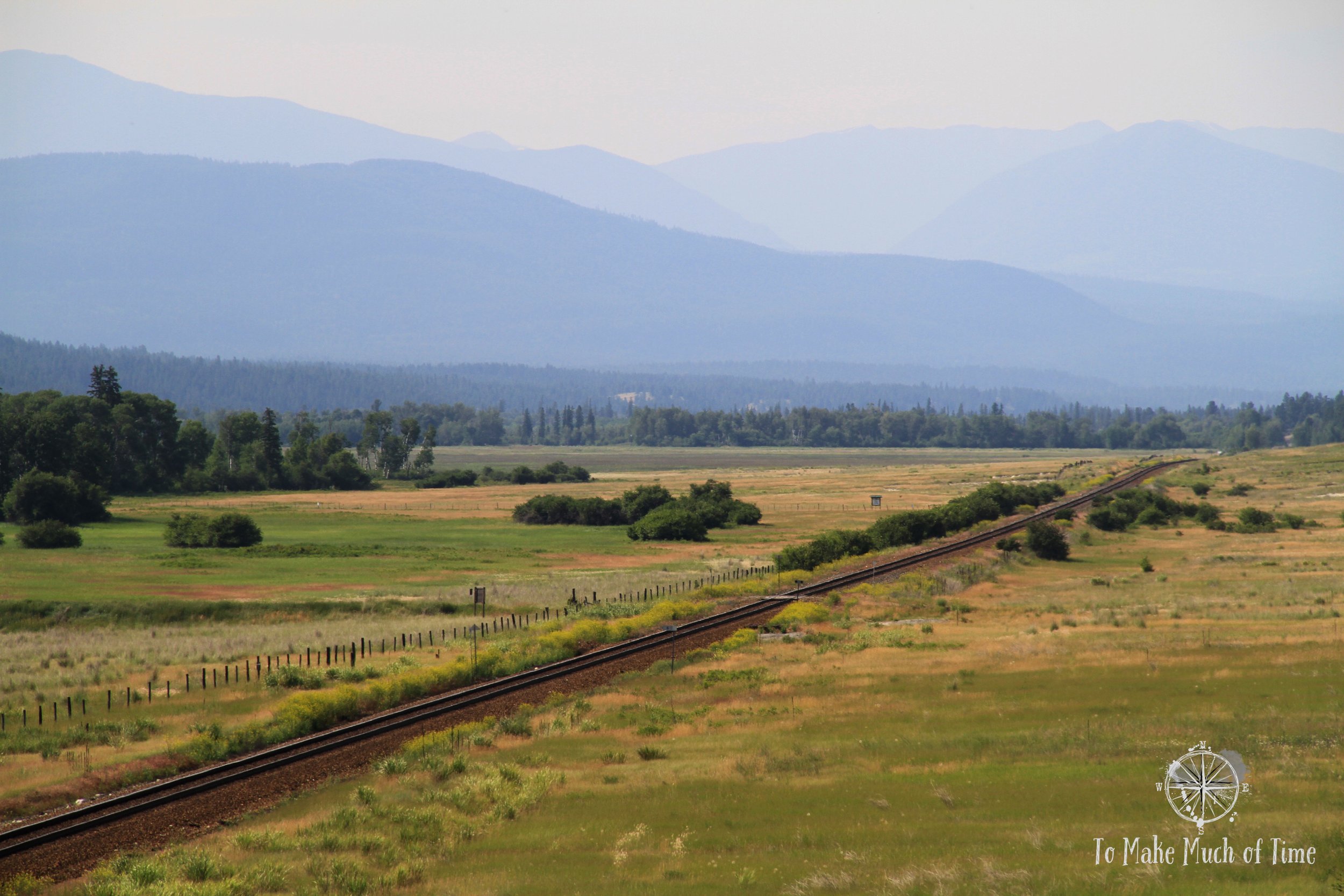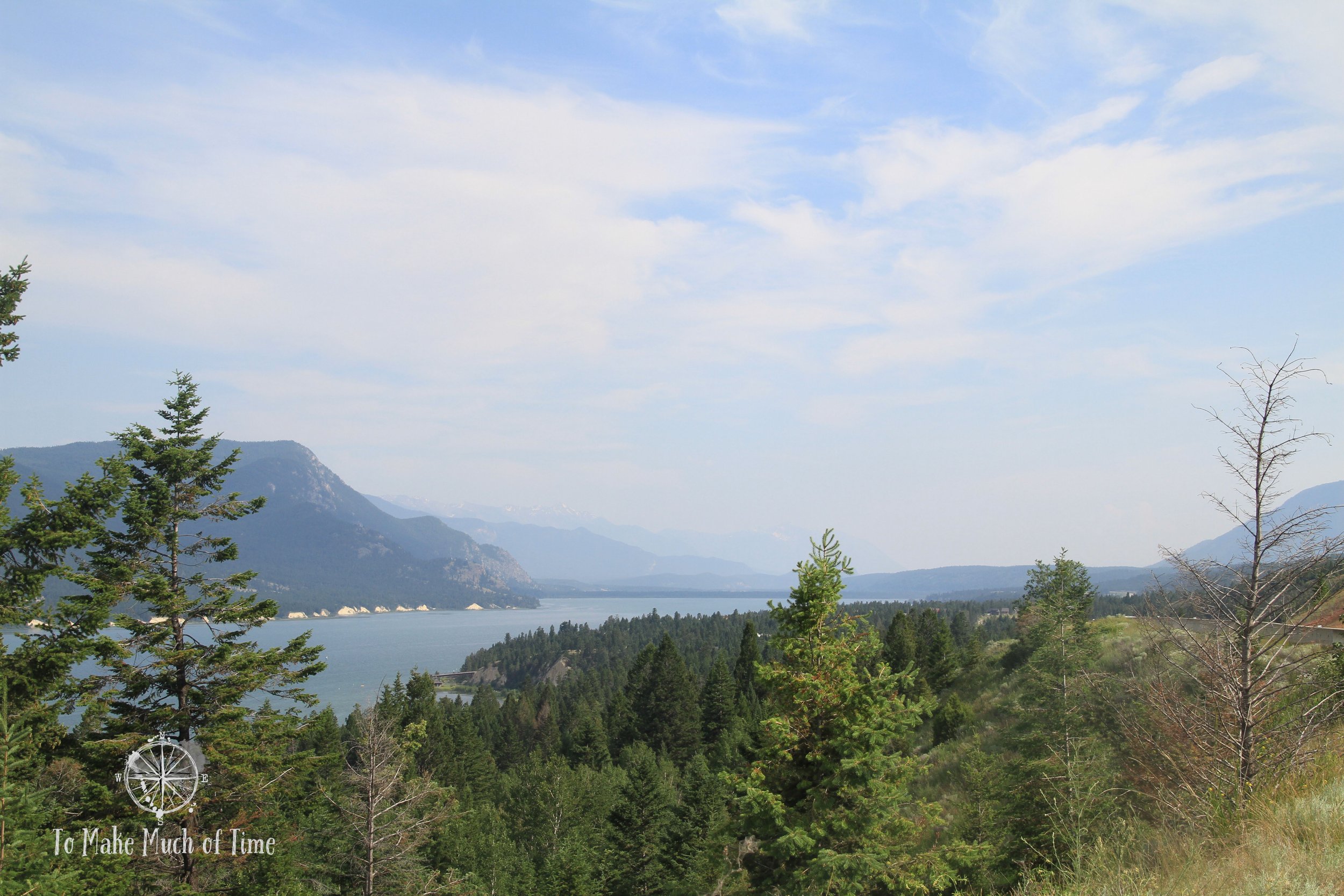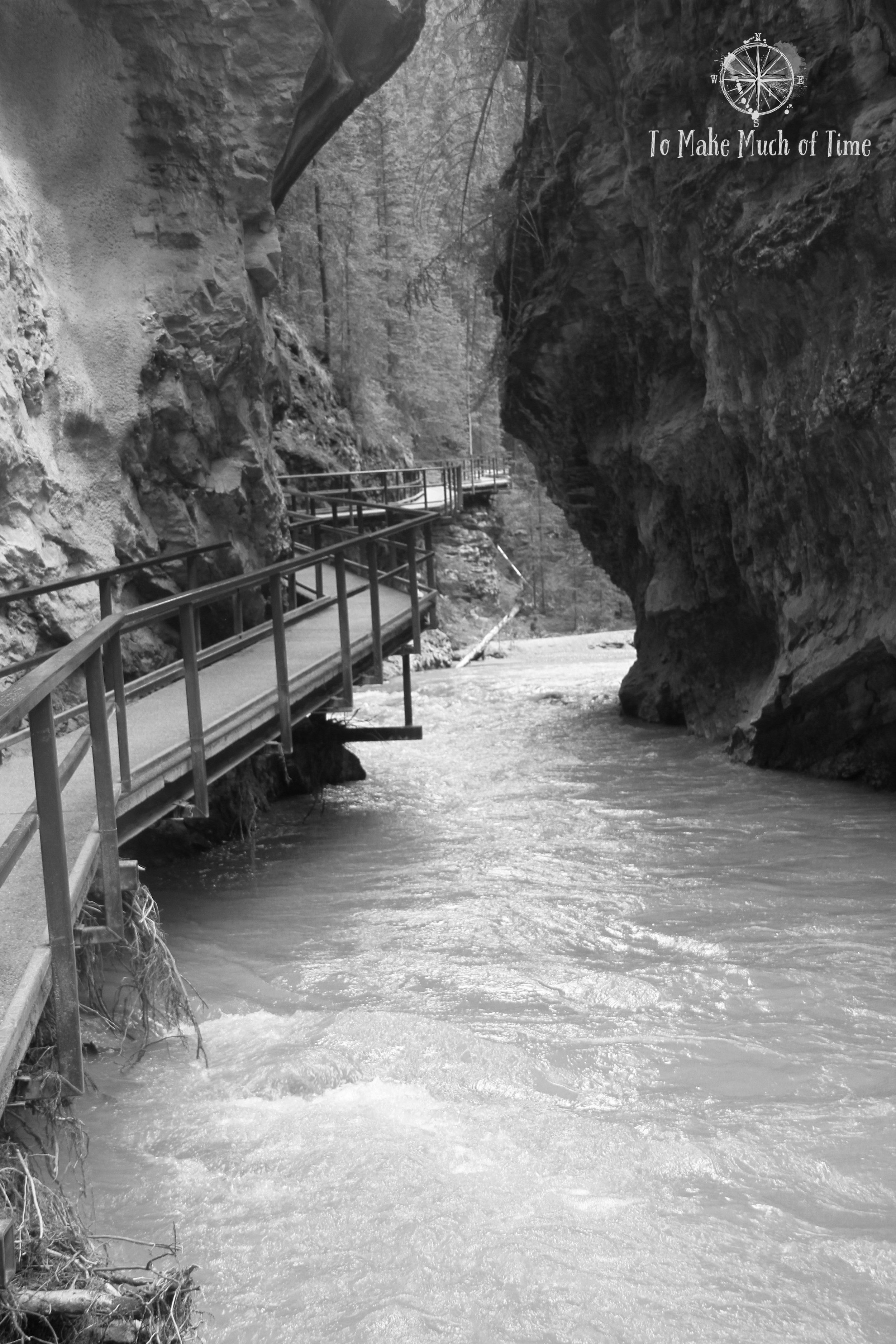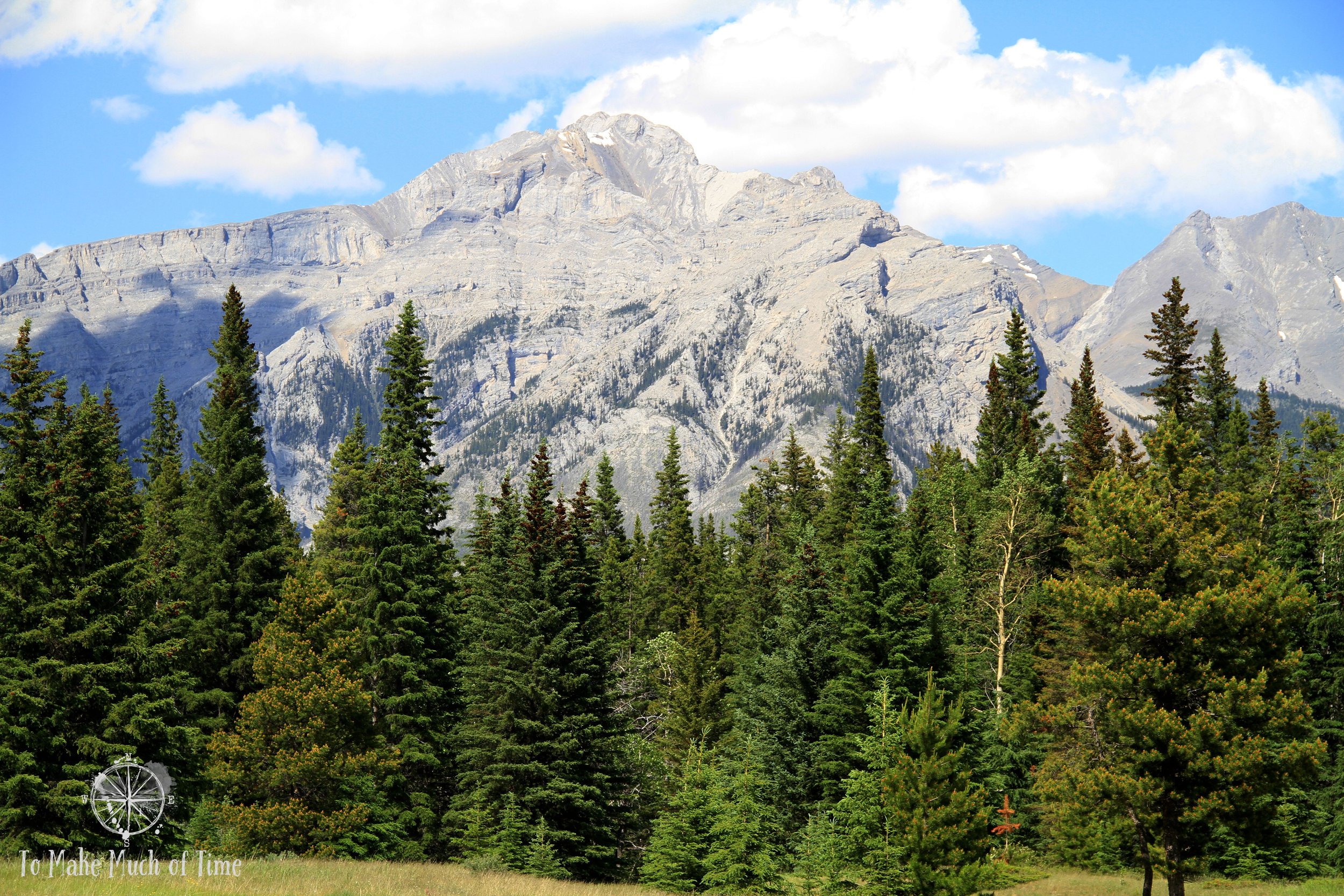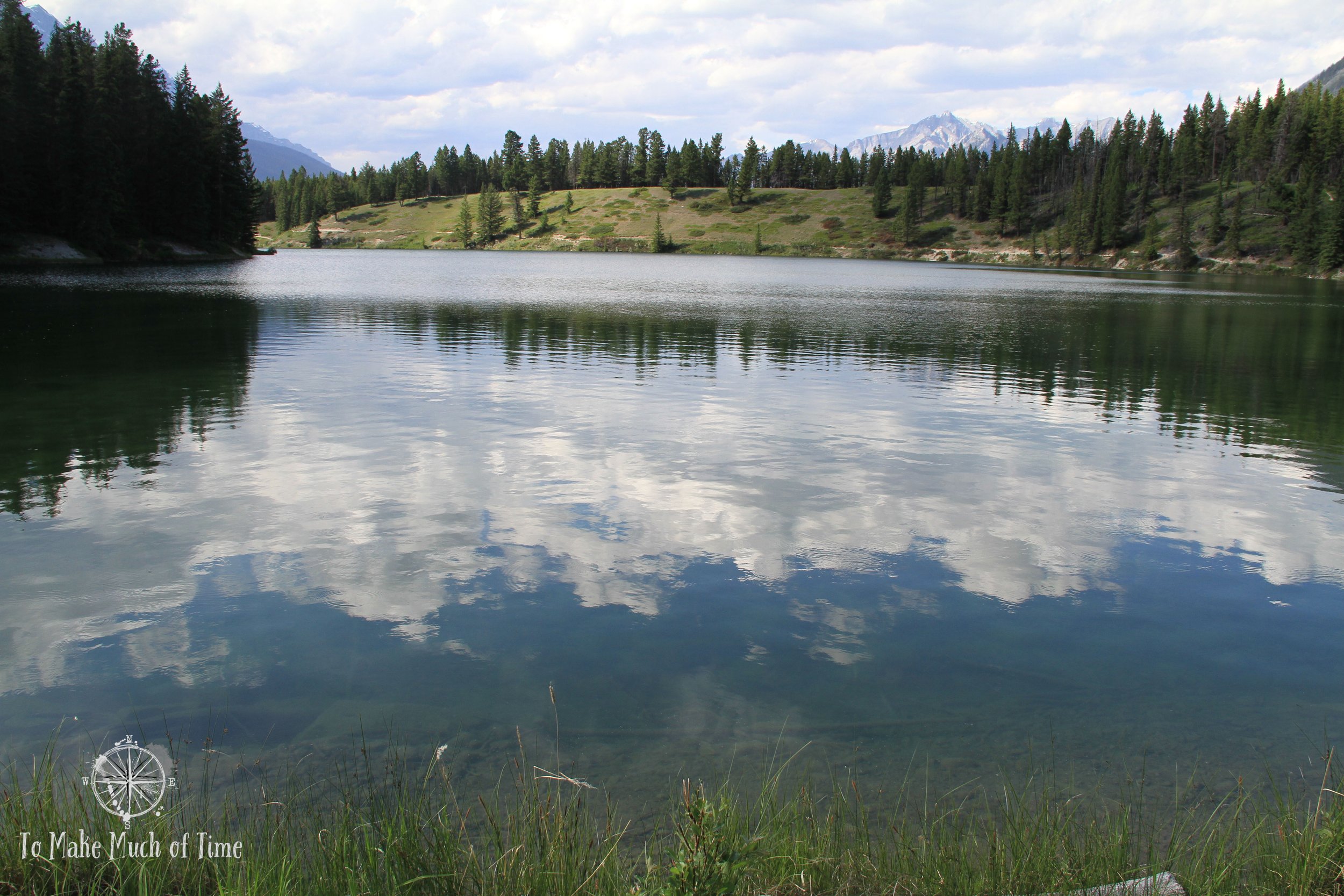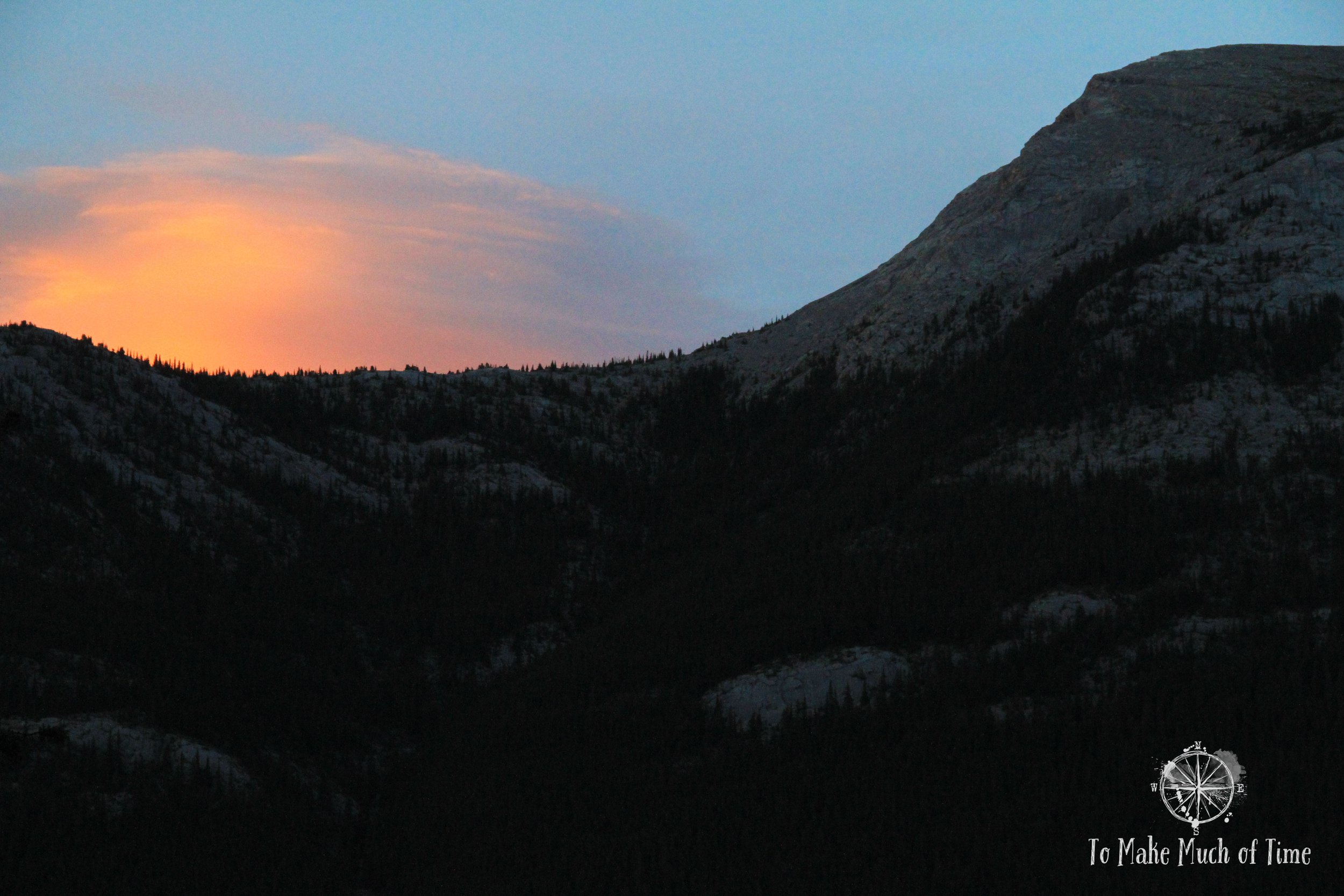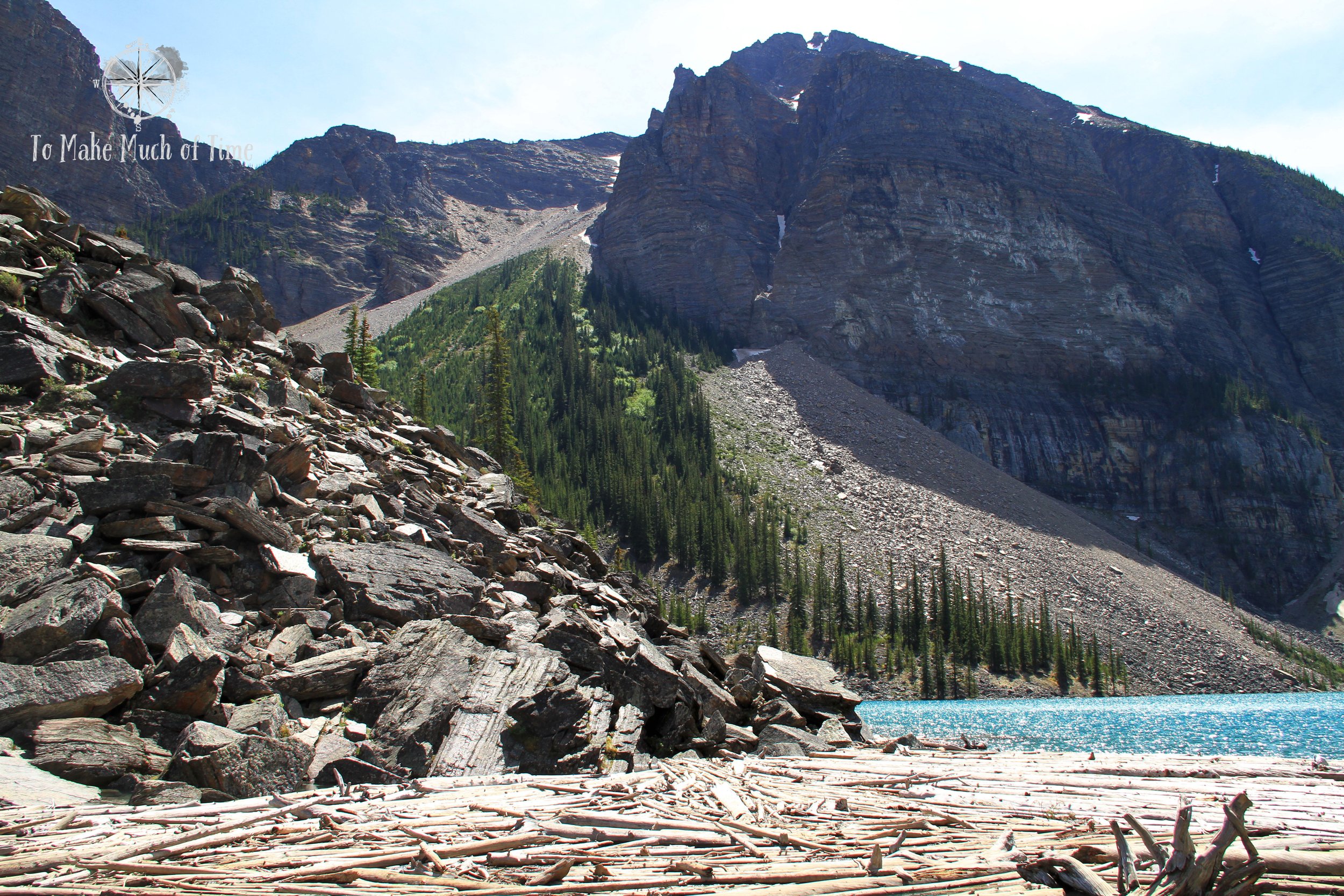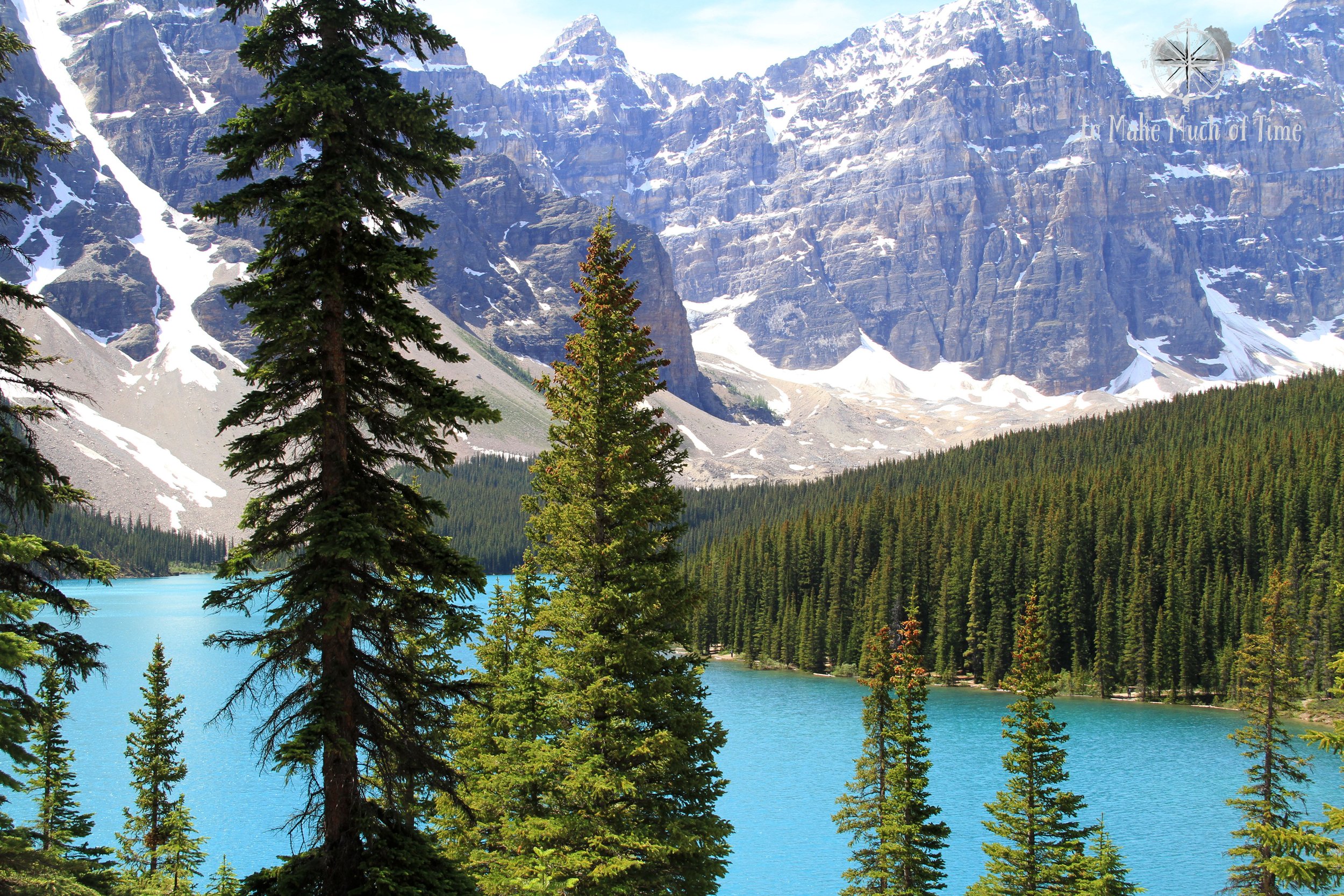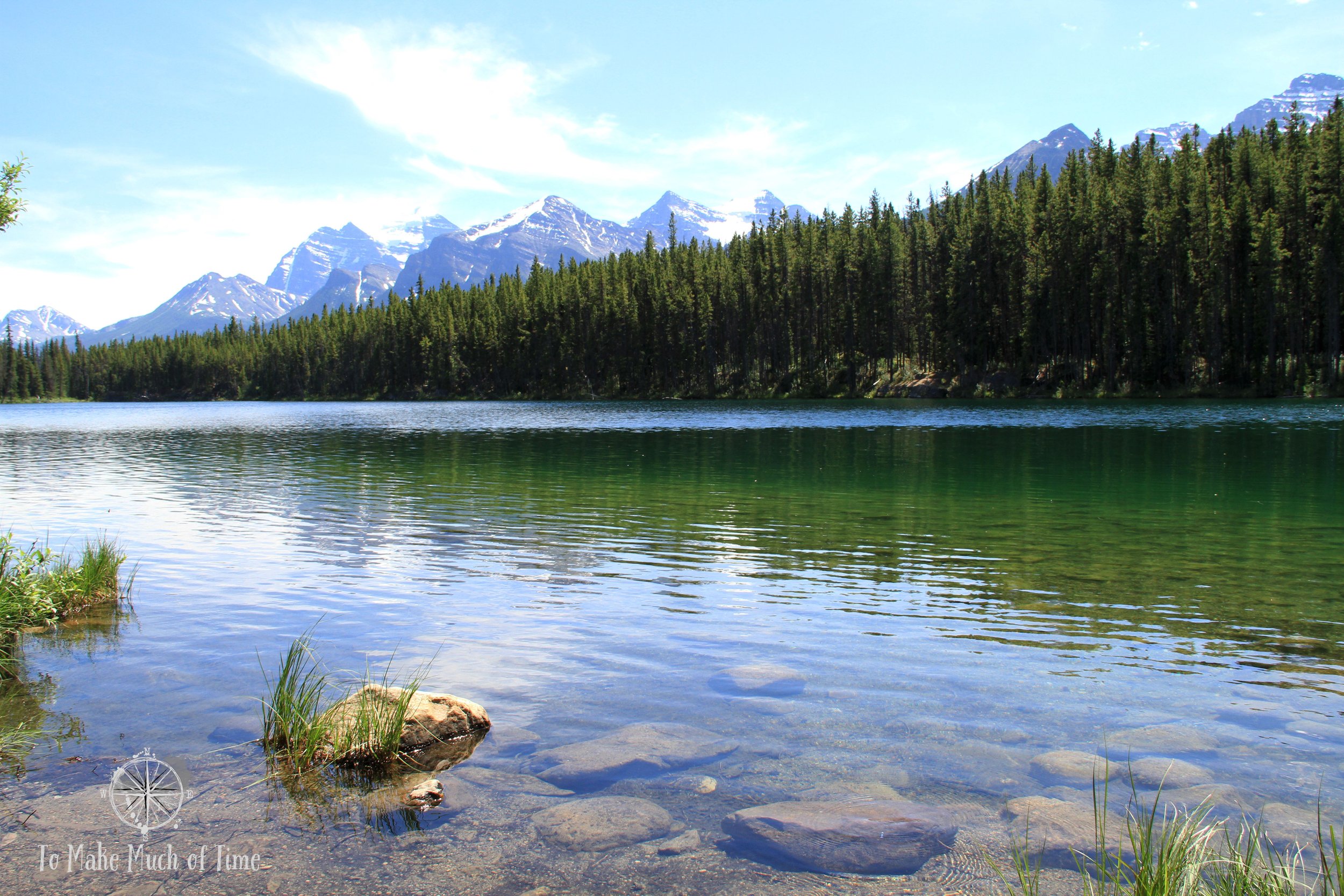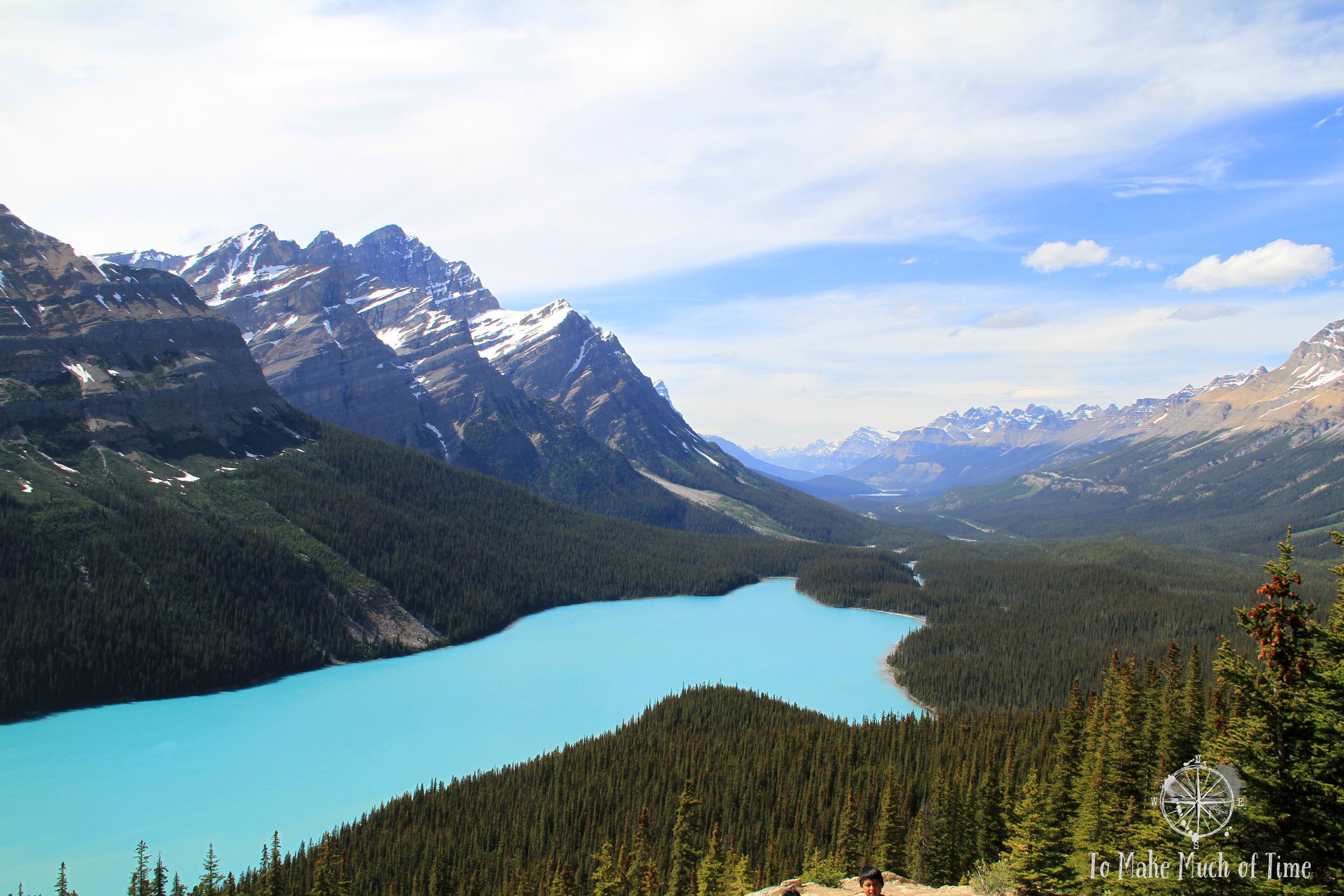Pacific Northwest & Western Canada Road Trip: Banff (Days 8-11)
Note: Some links throughout our site are affiliate links, which means we may receive a small commission at no cost to you.
Three Days in Banff, Alberta
The drive from Spokane, Washington to Banff is about 6 1/2 hours but of course that is only if you drive straight through. Stopping for the necessities like food, gas, and bathrooms means it is a pretty solid day’s trek, also dependent upon the border crossing from the US into Canada. The drive left the state of Washington pretty quickly and then spanned much of Idaho’s panhandle before crossing into Canada. From there, the topography began to change with the towering mountains first in the distance and then rising up and around us until we climbed ourselves up into them.
By the time we pulled into the quaint town of Banff, it was late in the day, about 3 hours before sunset, which falls around 10pm at midsummer. The town itself has the aura of many small, architecturally designed ski towns where the buildings in the town fit together as part of a cohesive unit, a pleasant change from other spots that are incoherent strip malls. The town is a short drive off the main road, nestled against the foothills, and is home to various shops, galleries, restaurants, and the regular town buildings that the year-round residents need. Several of the resorts and neighborhood streets were on the other end of the downtown on streets that climbed in altitude.
While Banff is a popular destination for lovers of the outdoors, it is still a small town. The population is less than 8,000 residents. The altitude of Banff is just slightly lower than Denver, Colorado, about a mile above sea level, and while we don’t seem to have issues with that altitude ourselves, others may need time to adapt to it.
where we stayed in banff
We stayed at the Rimrock Resort Hotel, up in the mountains sitting over Banff. Some of the rooms, including ours, had gorgeous mountain views out the windows. While the hotel is convenient to downtown Banff and all the surrounding areas, it is not particularly walkable. The walk from the hotel to Banff would take about 45 minutes. Just slightly uphill from the resort is the Banff Upper Hot Springs, which attracted bathers. While we didn’t have our swimsuits, we did hike up to the hot springs for an even higher elevation view to watch the sun set our second night in town. There is also a Banff gondola that is accessed near the resort.
Our stay was really nice, and we used on the on-site parking for our rental car. The hotel also had a brunch buffet that we used as a way to fill ourselves up each morning before heading out into the wilds. As a resort in a popular mountain town, this is not a cost-conscious option for travelers but was a great stay for our time in the town.
Banff: Our First Evening
On our way in to Banff after the long drive, we got a taste of the scenery and also spotted our first (of many) Bighorn Sheep and bears. In this case, it was a juvenile black bear, but we also saw our fair share of Grizzlies. Summer is the bear breeding season, so there were plenty of warnings about erratic bear behavior, recommending hikers avoid some trails and travel in groups.
A view on the drive into Banff from the valley below.
Our first Bighorn Sheep spotting.
Drivers in Banff always need to be on the look-out for wildlife crossings.
A black bear coated in his dandelion snack.
Like this black bear, our dogs also enjoy eating dandelions.
This juvenile black bear barely batted an eye at us in our car.
View near Banff
View near Banff
View near Banff
View near Banff
View near Banff
Banff: Day 1
what we did in banff: johnston canyon hike
Johnston Canyon Hike is one of the more popular hikes in Banff for a reason: the trail, in many places experienced as an elevated catwalk, maneuvers through a rocky, deep canyon filled with flowing, icy blue water of Johnston Creek. The path provides views of a combination of rapids and small waterfalls. There are two trail options: a hike to the lower falls (1.5 miles total round trip) or continue on to the upper falls (3.1 miles total round trip). As this was our first stop in Banff, we were mesmerized by the color of the water.
Rock layers are very visible as you hike through Johnston Canyon
Rushing Johnston Creek
Johnston Creek water is a pale, milky blue-green shade
View from Johnston Canyon hike
Fast-moving Johnston Creek pulled trees and sediment along
Johnston Creek can be seeing continuing to carve away at the rock-face
Rainbow at Johnston Canyon waterfall
Rainbow at Johnston Canyon waterfall
Much of the Johnston Canyon hike is along a raised catwalk
Much of the Johnston Canyon hike is along a raised catwalk
Rapids and waterfalls at Johnston Canyon
Johnston Canyon waterfall
what we did in banff: lake minnewanka scenic drive
The Lake Minnewanka Scenic Drive is about 15 miles in length and is not a drive around the lake, as the name might suggest. For the most part, the scenic drive provides beautiful scenery in the Banff area and perhaps a third of the route hugs the shorelines of Lake Minnewanka and Two Jack Lake. This is a route to be driven slowly to feast on the views and also be cautious of wildlife! We saw more Bighorn sheep on this route than we did anywhere else in the Banff National Park. At times, they wandered in groups right down the road, not unlike all varieties of sheep worldwide. We happened upon signs to Johnson Lake, just off of the scenic route and decided to check that out.
As part of the scenic drive, visitors can check out the Bankhead Ghost Town, a former mining town’s ruins. The town’s heyday was in the early 20th century and played a vital role in mining coal to power trains. There is a short interpretive walk that goes through the ruins of buildings and mining operations. By the time we got to this part of the scenic drive, rain had moved in and so we were unable to explore it ourselves.
View from Lake Minnewanka Scenic Drive
View from Lake Minnewanka Scenic Drive
Wildflowers on Lake Minnewanka Scenic Drive
View from Lake Minnewanka Scenic Drive
Lake Minnewanka
Lake Minnewanka
Bighorn sheep aplenty on the Lake Minnewanka Scenic Drive
Lake Minnewanka
View from Lake Minnewanka Scenic Drive
View from Lake Minnewanka Scenic Drive
Bighorn sheep also like to make the Lake Minnewanka Scenic Drive one hoof at a time
what we did in banff: johnson lake hike
Just off the Lake Minnewanka Scenic Drive loop sits Johnson Lake, surrounded by beautiful mountain peaks. We took an evening stroll around the lake on the loop path that hugs the shoreline. At 1.8 miles in length and an easy trail, this is a great walk for hikers and visitors of all abilities. As you can see in the progression of our photos below, we started off with a mostly blue sky, puffy white clouds dotting the blue in the distance and then the wind picked up as a storm moved in. Weather can change really rapidly in a place like Banff, so it’s important to always be aware of your surroundings and plan for unexpected storms. My camera ended up bundled up under clothes to protect it from the rain.
Some of our favorite photographs from our trip were taken on this loop trail, including the photo on our blog homepage (here). As both an unexpected, interesting, and sort of creepy side path, you can visit the remains of a hermit’s cabin. Billy Carver built a cabin around 1910 and lived there for twenty-seven years until some locals realized he was in poor health and moved him to a home where he could be cared for.
Johnson Lake near Banff
Johnson Lake near Banff
Johnson Lake near Banff
Hermit Billy Carver’s home just off the Johnson lake loop trail
Hermit Billy Carver’s home just off the Johnson lake loop trail
Johnson Lake loop trail views
Johnson Lake loop trail views
Johnson Lake loop trail views
Johnson Lake loop trail views
Rainstorm while hiking Johnson Lake’s loop trail
Rainstorm while hiking Johnson Lake’s loop trail
Rainstorm while hiking Johnson Lake’s loop trail
View along Johnson Lake loop trial near Banff
Rainstorm while hiking Johnson Lake’s loop trail
Rainstorm while hiking Johnson Lake’s loop trail
what we did in banff: sunset photography
Between the weather patterns caused by the mountainous terrain and the beautiful landscape, sunset in Banff is not to be missed. For our time in town, we made a point of taking in the sunset and getting some pretty epic pictures along the way with vistas that honestly don’t even look real but aren’t photoshopped. The best tip for sunset photos in Banff is to find a spot with a bit of elevation or away from anything that blocks your view and then watch the show unfold! For these, we walked just up the hill from our hotel, Rimrock, to the road in front of Banff Upper Hot Springs. We were joined by a small gathering of others, equally mesmerized by the pastel dance of clouds, some sunlit in a way that made the sky look like it held multiple suns at once, though none were the sun itself, which had already crept below the horizon.
Sunset in Banff
Sunset in Banff
Sunset in Banff
Sunset in Banff
Sunset in Banff
Sunset in Banff
Sunset in Banff
Sunset in Banff
Sunset in Banff
Sunset in Banff
Sunset in Banff
Banff: Day 2 - Touring Five Banff-Area Lakes
The route from the main road through the national park to the town of Banff crosses a railroad track. As we headed out of town on our second morning, we stopped to get a few photos of the photographic sight before coming across a grazing, if such a word can be used in this case, grizzly bear. While we grabbed a quick photo from our car and headed on our way, leaving the bear to his snack in peace, we observed here again what we observed everywhere on this trip and trips far from here where people just get too darn close to wildlife. Perhaps park rangers the world ‘round should start passing out zoom lenses to people so they can get a close-up look from a safe distance.
The theme of our second day was lakes. We spent about 7 hours out and about, exploring Moraine Lake, Herbert Lake, Hector Lake, Bow Lake, and Peyto Lake. By the time we got to Peyto Lake, the furthest north, we were about an hour and 15 minute drive north of Banff. All of these lakes are right off of the highway that runs through the park, so this itinerary is as simple as following one main road and scoping out the lakes, hikes, and scenery along the way.
Banff railroad track
Grizzly bear on the outskirts of downtown Banff
Banff railroad track
Banff railroad track
what we did in banff: moraine lake
Moraine Lake, sitting in the Valley of the Ten Peaks (evident in the photos!), features a 3.2 mile (in total) out-and-back trail that skirts about half the lake’s shoreline. For those not wanting to make the entire hike, I’d recommend doing what we did and just hike the first portion, which includes a slight elevation climb and rewards you with more of an aerial view of the lake and mountains.
Moraine Lake, like nearly all the lakes in the area, are a crisp, sometimes nearly neon blue shade. This lake will be instantaneously recognizable as it is one of the most photographed spots in Banff.
Moraine Lake
Moraine Lake
Moraine Lake
Lots of rock piles at Moraine Lake
Moraine Lake
Moraine Lake
Moraine Lake - easy to see why this is called the Valley of Ten Peaks!
A view near Moraine Lake
what we did in banff: herbert lake
Herbert Lake is relatively small by the standards of its neighboring lakes and appears to be overlooked. When we visited, there was no one else there. What makes Herbert Lake special is that in contrast to the bright blue glacial lakes in the area, this one features a green hue, visible in the first of our photos below. While there was a slight breeze that rippled the surface during our visit, when the air is calm, this lake has a reputation for providing a beautiful, glass surface for reflections from the surrounding area.
Herbert Lake offers a one-mile loop trail that roughly follows its shoreline, and it is an easy level of difficulty.
Green-hued waters of Herbert Lake in Banff
Clear water of Herbert Lake in Banff
what we did in banff: hector lake
We did not make the drive in to Hector Lake itself, but the good news is that it is visible directly off the main highway with a pull-out Hector Lake Viewpoint, marked as such on Google maps. Just before pulling over to take in the smattering of blue water that weaves in and out of rows of green trees, we spotted a bear dining on the side of the road and got a few photos of him. At the viewpoint itself, we were visited by a raven, which was remarkably large standing on the ground next to us. He was fascinated by something on the pavement and pecking at it, which kept him nearby even with us there.
For those who do decide to visit Hector Lake instead of taking it in from afar, it offers a 2.8 mile out-and-back hike that takes hikers through the surrounding area and ends at the lake itself.
Foraging bear in Banff
View from Hector Lake Viewpoint
View from Hector Lake Viewpoint
what we did in banff: bow lake
Bow Lake is a nice spot to sit along the shore for a picnic and enjoy the ridiculously clear water, shoreline wildflowers, and the curve of the shore and tree-line into the surrounding mountains. It is near Peyto Lake, our next and final lake stop of the day, and I’d recommend visiting both.
Bow Lake in Banff
Bow Lake in Banff
Clear water of Bow Lake in Banff
Bow Lake in Banff
Bow Lake in Banff
View from a picnic pavilion
what we did in banff: peyto lake
There is a short walk from the Peyto Lake parking up to the Peyto Lake Viewpoint, from which you can see the wide expanse of the snake-shaped lake. As with many other lakes in the area, you can see the spots from which the glacial melt travels down the steep mountains, picking up minerals along the way that provide the gorgeous hues to the water. The walk to the viewpoint is roughly ten to fifteen minutes through the woods and uphill.
Hike to Peyto Lake Viewpoint
Peyto Lake
Mountain runoff into Peyto Lake
Aerial view of Peyto Lake
Banff and Calgary: Day 3
After our two full days in Banff, our third day was sadly going to be the day we left the area to head to Calgary in advance of catching our flight the following day. With the drive to Calgary taking a bit less than an hour and a half, we hoped to spend some time exploring Banff more; however, we woke up to a rainy morning so instead had a final buffet brunch at the hotel and packed up.
Driving from Banff to Calgary is a shock to the system. We left the mountains and lakes behind quickly as the highway traveled downhill, losing elevation at a fast clip, and entering what is best described as a desert-like setting. Calgary reminded us of spots in the US like the southwestern states, and it felt like a city that reached its heyday in the 1980s. Coming down the highway, we passed remnants of the winter Olympic infrastructure from the 1988 games held there.
Because Calgary was meant to be a terminus, a pre-airport stay, we had not previously researched anything to do in the area and ended up relaxing at our hotel before grabbing a bite to eat and getting to bed at a reasonable hour. While at dinner, someone asked if we were in town for the Calgary Rodeo, which was absolutely not on our radar at all. Apparently the Calgary Stampede Rodeo as it is officially named dates to 1912 and is a very big event in the world of rodeo. Not our cup of tea, but it was interesting to become aware of this.
We stayed at the Residence Inn Calgary Airport using Marriott points accrued through work travel, and it was a perfectly solid airport hotel option that made the final logistics easy. Traveling from the west coast to the east coast at the end of the trip is always rough to me because in addition to being sad that a trip is over, it is compounded by losing several hours due to time zone changes so while we had to pretty much get to the airport first thing to return our rental car and ensure early arrival for our international flight at 11am, we didn’t arrive home until after 10pm that night.
Our route from Spokane to Banff, with Calgary visible for our departure airport:
Click the image below to save this post to Pinterest!
Check out our other posts about this road trip through Vancouver, Seattle, Spokane, and Banff:


